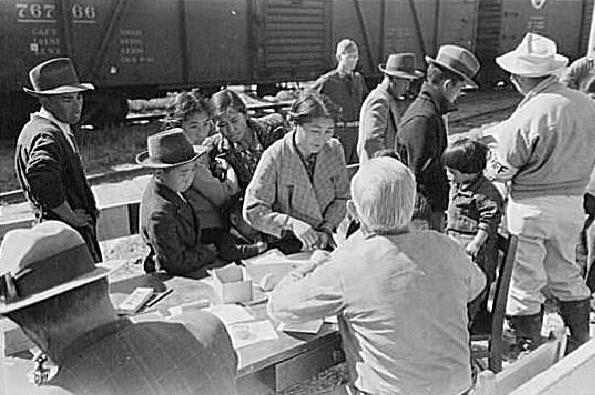
Internment of Japanese Americans: Temporary Camps

Figure 1.--This is the trgistration process at the Santa Anita reception center at Los Angeles, California. The evacuation of Japanese and Japanese-Americans from West Coast areas took place under U.S. Army war emergency order. Here the arriving Japanese-Americans are being registered in April 1942. Source: United States. Office of War Information archived in the Library of Congress.
|
The Army issued "evacuation" notice orders. Japanese Americans were put on trucks, buses, and trains. They were initially transported to "Assembly Centers". The Army set up 15 transit detention camps. Barbed wire and armed guards were use to convert facilities like racetracks and fairgrounds. Here they had to wait facing search lights, watch towers, and barbed wire. Families were allowed to stay together. Families sought what ever shelter was availavle such as horse stalls. Sanitary conditions were terrible. Toilet and bathing facilities were very basic. There were open sewers. Many lived in barracks quickly contructed. There were lines for everything. The food was inadequate and medical attention was almost non-existent. The inernees spent only a few months in these temporary camps. As soon as possible, the Army moved the internees to permanent camps. By October 1942 they had been moved to permanent camps.
HBC

Navigate the Boys' Historical Clothing Web Site:
[Return to World War II interment of Japanse-Americans ]
[Return to Main American 1940s page]
[Return to Main World War II page]
[Introduction]
[Activities]
[Biographies]
[Chronology]
[Clothing styles]
[Countries]
[Bibliographies]
[Contributions]
[FAQs]
[Glossaries]
[Satellite sites]
[Tools]
[Boys' Clothing Home]
Created: 4:18 AM 11/30/2005
Last updated: 4:18 AM 11/30/2005



